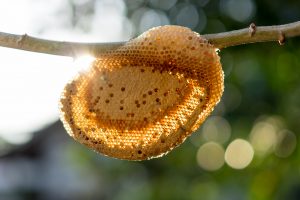Bees and wasps are brothers on the evolutionary chain. They are so close they sit in the same Order as species like bees and even act similarly. The larval stage looks almost identical and many scientists believe that these insects may have evolved from bees while others believe the wasp evolved parallel to the bee as a wolf in sheep’s clothing. Either way, wasps are quite different from bees but in many ways the same. They differ mostly in their nesting habits, their food acquisition and their sociability. While both bees and wasps are familial and have a queen wasps do not generally make their honey. Unlike bees who make nests out of beeswax the wasp makes nests out of wood grain, they look like paper and come in a wide variety of shapes, sizes and locations. A bee’s nest is often yellow or golden and shines in the light, some bees will coat their nests in a similar paper like wasps but most often the nests are just beeswax.

Bees are much less aggressive than wasps but will defend their nest if threatened. The bee’s stinger is a defensive weapon and they know not to use it unless it is their last hope because as soon as they sting you they will die. This is a major difference. Female wasps can sting indefinitely, over and over, they do not die when they lose their stinger and their stinger unless it breaks off, does not stay in you as a bee stinger does. That is why a bee sting can be more painful and hurt for longer.
Wasps are also easily provoked, unlike bees. Bees will ignore you like drones if you enter their territory, they will only get mad if you threaten them or their nest by waving your arms about or spraying insecticide. Wasps will attack you simply for walking on their property. They have no issue stinging a human over and over again and if there is a swarm you may be rendered unconscious while the swarm continues to sting you. This can be life-threatening and a swarm of wasps can most certainly kill a mammal.
This is why it is important to take precautions at the beginning of the wasp season. Inspect your home from top to bottom, look for a small pocket nest. This will be the queen’s initial nest. You can kill with any domestic grade pesticide that is specifically designed for killing wasps. If you do it now, at the start of the season, then you will have prevented a full nest from developing.

